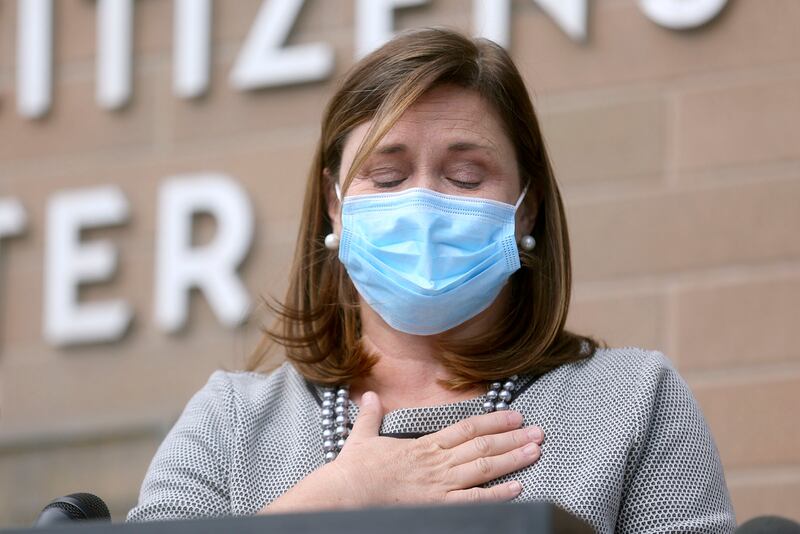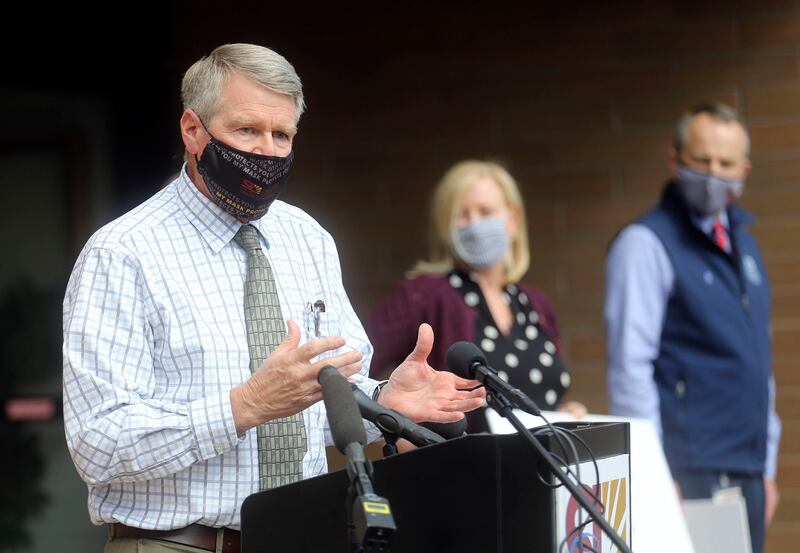SALT LAKE CITY — Brian and Amy Nicholson have done their best to follow the state health directives throughout the pandemic.
But after their experience this week when they attempted to have their son tested for COVID-19, they’re left wondering if some are really as concerned as state officials repeatedly profess. Even as the state revamped its transmission risk guidelines, testing issues persist.
“It’s not about whether I’m inconvenienced or not,” Amy Nicholson said. “People’s lives are on the line. I’m trying to take it seriously, but when I spend all day and can’t get my son tested, it doesn’t feel like the people in charge are taking it seriously.”
On Wednesday, the state reported 1,144 new cases with a seven-day average for positive tests at 1,204 cases per day. The state reported 8,955 new tests and a positive rate of 13.9%, which is also a seven-day average.
The state reported 259 people hospitalized, which is 10 more than were hospitalized on Tuesday.
The state also reported five new deaths. Salt Lake, Utah, Cache and Wasatch counties all reported deaths.
The youngest was a Salt Lake County man between the ages of 45 and 64 who was hospitalized when he died. The others were a Utah County man between 65 and 84 who was hospitalized when he died; a Salt Lake County man between 65 and 84; a Wasatch County woman older than 85 who was in a long-term care facility; and a Cache County man older than 85 who was in the hospital when he died.
To date, 527 Utahns have died from COVID-19 complications.
On Wednesday afternoon, Salt Lake County Mayor Jenny Wilson held a press conference to discuss the impact of COVID-19 on aging and vulnerable populations. In illustrating the impact of the pandemic on all aspects of life, Wilson shared how COVID-19 restrictions have impacted her personally.
“I continue to be dumbfounded by messaging from our president, and others who believe him, that this is not a community crisis,” she said, choking back emotion that overcame her as she talked about losing her mother-in-law recently, and how coronavirus restrictions meant her children could not see their grandmother before she died. “It’s false, it’s dangerous and it’s misguided for the president to continue those conversations.”

She expressed gratitude for Utah’s new transmission guidelines, which acknowledge the fact that situations in smaller, rural communities could impact hospitals along the Wasatch Front as they take patients who need specialized or COVID-related care.
“This is a real crisis,” she said. “Our need around this is more urgent right now. ... What it really tells us is that groups and group gatherings of any form should not continue. That means not inviting family over to the house on Sunday. It means fewer people over to dinner and socially distancing in those settings. ... We need to each, individually, make wise choices.”
Since the first week of September, the state has seen 220 hospitalizations of people age 60 or older. There have also been 42 deaths in that age group — just in Salt Lake County.
“That is shocking, and it’s heartbreaking,” she said. “Even those in their 40s, 50s and 60s are at an increased rate of hospitalization.”
About one-third of those who test positive for COVID-19 end up needing hospitalization. About 18% of those in their 80s will die.
“That’s not OK,” she said. “We have got to do more to keep our seniors safe.”
Gary Edwards, executive director of the Salt Lake County Health Department, said the health care system is not “an infinite resource ... and we’re very close to overtaxing that system. Last week we had the highest number of hospitalizations in a week. ... We have some facilities that are at 95% ICU capacity.”
“As a county we’re doing ... well with mask wearing,” he said, expressing gratitude to county residents for their support of these efforts. “But when we’re out in the open or when we’re with family and friends, we sometimes let our guard down. Most of the cases of COVID-19, up until now, have been contracted through those close contacts.”

He continued, “If you don’t live with someone, and you’re around them, then you need to be wearing a mask around them.”
Wilson said that it’s “our social interactions” that are responsible for the continued high numbers for Salt Lake County despite a mask mandate that goes back to midsummer.
Obstacles to testing
Making responsible choices is what the Nicholsons thought they were doing after their 15-year-old son called from school to let them know his runny nose and sore throat now included a worsening cough. They picked up their son from school, but because they had a family trip planned this weekend, they decided they needed to get him a COVID-19 test so they’d know if it was just a cold or if they needed to cancel the trip.
What followed was a series of frustrating, time-consuming experiences. Amy Nicholson’s mother suggested they get the teen tested at the North Ogden clinic because she’d gone there for a test and it was a quick drive-thru process.
She called and was told she needed to get an order from a doctor, which she could do through the COVID-19 hotline. Two different calls to the hotline totaling about two hours allowed her to get the QR code she’d need to get her son tested at the clinic’s drive-thru.
“By the time she got the QR code, the clinic was closed,” Brian Nicholson said. “The COVID testing closed at 3 p.m. and she got there at 3:45 p.m.”
Brian Nicholson drove his son to Walgreens, which has drive-thru testing that doesn’t require a doctor’s referral, but they had a sign posted saying they were closed because they’d run out of testing materials due to high demand. He attempted to make an appointment at another Walgreens, but it was in talking with an actual human at the store that he learned those under 18 cannot be tested there.
“Since my wife had the order given to her yesterday, we went to the clinic this morning,” Brian Nicholson said Wednesday. “We got there a few minutes early, and got his test done. They gave us a pamphlet with another QR code that would give us the results. I scanned it, and it takes you to a site to download the My Health Plus app with IHC.”
Brian Nicholson created his account, but he had no access to the medical records of his children. He made a phone call where he was told he could call and do it over the phone, which needed to include a video conference where they could take his picture and verify his identity, or go to a provider. After being told the wait online was two hours, he called McKay-Dee Hospital.
“They sent me to a phone number, which referred me back to the hotline where I had to wait for two hours,” he said Wednesday as the family continued to wait for his son’s test results.
“It doesn’t surprise me that the public is skeptical. This kind of madness is creating more skepticism than anything. I’m trying to do all the things I’m supposed to do, all the things Gov. Herbert and Dr. Dunn recommend ... but it doesn’t feel like the state is really concerned about getting everyone tested.”
He questioned why there aren’t multiple testing options after hours, and wondered how anyone can manage the time commitments required to secure a testing opportunity.
“If they want to get kids tested, they should do a better job,” he said. “You have to be committed (if you want a test). And you have to have disposable time. ... I am self-employed; if you had a job that isn’t accommodating, you’re screwed.”
Testing issues have persisted, despite repeated public statements from county and state leaders that testing is available for anyone who wants or needs it. The logistical realities, however, highlight why some might forgo testing, and why some don’t have faith in the numbers being used to place restrictions on people and businesses.
And testing results still vary, with some people complaining they’ve had to quarantine more than a week while awaiting results. The statewide average turnaround time for test results is 2.2 days, according to Tom Hudachko, spokesman for the Utah Department of Health.
Jess Gomez, spokesman for Intermountain Healthcare, said it is constantly evaluating how it can more efficiently administer tests and deliver results.
“We have more sites than anyone else,” he said. “The issue has been the significantly increasing demand.”
Intermountain has made a number of changes to the process so that patients don’t wait in long lines at testing sites, but the bottom line is the number of people seeking COVID-19 tests is the highest it has ever been.
“It’s a challenge,” he said. “In the last three weeks, the demand has been the highest it’s been, even higher than July. And we’re working hard to ensure we can meet that demand. We are continually looking at the testing process and trying to improve that.”
On Tuesday, Gov. Gary Herbert announced a new way to gauge the risk associated with rising COVID-19 case numbers. Instead of the previous color-coded guide that placed restrictions on the number of people that could gather, even at private family events, the new system combines case counts with positive testing percentages and intensive care unit capacity.
The only counties in the high level of transmission are Salt Lake, Utah, Cache, Juab, Wasatch and Garfield. Under the old guidelines, only Orem and Provo were considered moderate risk, while the others were considered low risk. Now the entire county is under the same risk level.
So how different is the new system from the old? In some ways, there are massive differences. For starters, masks are required in all areas that are determined to have a high level of transmission. But there are no longer restrictions on crowd sizes. Instead, if the gatherings are public, like a high school football game, the organization is required to ask attendees to wear masks and maintain 6 feet between family groups.
An illustration of how the rule changes could impact public events can be taken from a recent controversy. Provo and Orem were recently moved to moderate restriction level by state officials, and therefore Provo High couldn’t have any spectators, including cheerleaders, at its homecoming game.
When school officials attempted to move the game to Spanish Fork so students and parents could attend, it caused public outcry and Nebo School District officials told Spanish Fork it could not allow the schools to use its field.
Under the new rules, Provo, which as part of Utah County is now considered at high level of transmission, could have spectators (no limits on capacity). But like all other public events, at any transmission level, masks must be required and 6 feet maintained between family groups.
Casual gatherings, which is when private people get together, are exempted, but those are limited to 10 people in high-risk areas.
Those in moderate areas are limited to gatherings of 25 people, unless masks are worn. And there is a temporary mask mandate for those living or recreating in a moderate-risk area, if they’re in gatherings of 10 or more through at least Oct. 29.


